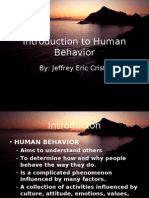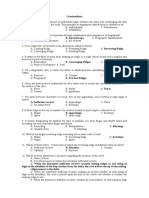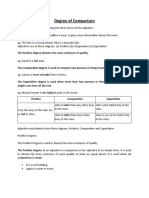Human Behavior Module1
Human Behavior Module1
Uploaded by
Arianne FarnazoCopyright:
Available Formats
Human Behavior Module1
Human Behavior Module1
Uploaded by
Arianne FarnazoOriginal Title
Copyright
Available Formats
Share this document
Did you find this document useful?
Is this content inappropriate?
Copyright:
Available Formats
Human Behavior Module1
Human Behavior Module1
Uploaded by
Arianne FarnazoCopyright:
Available Formats
UniversidaddeManilaUniversidaddeManilaUniversidaddeManilaUniversidadeManilaUnbersidaddeManilaUniversidaddeMan
ilaUniversidad
Universidad de Manila
CM Palma Street corner Arroceros, Manila
COLLEGE OF CRIMINOLOGY
Area: Human Behavior & Crisis Management
Content: human behavior , Criminal psychology , Crisis Management
Prepared by: JUAN PAOLO AGUIRRE
I. Understanding Human Behavior
A. Definitions
Human Behavior – is the voluntary or involuntary attitude of a person adopts in order to
fit the society’s idea of right or wrong.
B. Two Basic Types of Human Behavior
1. Inherited or Innate Behavior – refers to any behavioral response or reflex exhibited
by people dye to their genetic endowment or the process of natural selector.
2. Learned or Operant Behavior – it involves the cognitive adaptation that enhances
the human being’s ability to cope with changes in the environment and to manipulate
the environment in ways, which improve the chances for survival.
C. Characteristics of Human Behavior
1. Primarily native or primarily learned
2. Evoked by external stimuli or internal need
3. Automatic, voluntarily, conscious, or motor or intentional
D. Attributes of Human Behavior
1. Duration – how long , in terms of function of time. Meaning the the length of time
something continues or exists.
2. Extensity – Size , distance, location.
3. Intensity – Magnitude , mild, strong, disintegrative.
4. Quantity – normal, abnormal, misleading, unacceptability.
E. Cause of Human Behavior
1. Sensation – feeling or impression of stimulus.
a. Visual – sense of sight.
b. Olfactory – sense of smell
c. Cutaneous - sense of touch
d. Auditory – Sense of hearing
e. Gustatory – sense of taste
2. Perception – Knowledge of stimulus
3. Awareness – psychological activity, it is in accordance with the interpretation and
experience of object of stimulus.
F. Viewpoints in the Study of Human Behavior
Human Behavior and Crisis Management by JUAN PAOLO AGUIRRE Page 1
UniversidaddeManilaUniversidaddeManilaUniversidaddeManilaUniversidadeManilaUnbersidaddeManilaUniversidaddeMan
ilaUniversidad
There are several viewpoints in the study of Human behavior
1. Neurological – it emphasizes human actions in relation to events taking place inside
the body, especially the brains and the nervous system.
2. Behavioral – it focuses on the external activities of an organism that can be observed
or measured.
3. Cognitive – it is concerned with the way on how the brain processes and transforms
information in various ways.
4. Psychoanalysis – it emphasizes unconscious motives stemming from represses sexual
and aggressive impulses in childhood. According to the phychoanalitical theory by
Sigmund Freud, Freud believed that people could be cured by making conscious
their unconscious thoughts and motivations, thus gaining “insight”.
5. Humanistic – it focuses on the subject’s experience, freedom of choice and
motivation toward self-actualization.
G. Factors that Affect Human Behavior
1. Heredity – it is determined through genes. Genes are the segments of cell structures
called chromosomes by which parents pass on traits to their offspring; genes are
composed of chemical substances that give the offspring a tendency toward certain
physical and behavioral qualities.
2. Environment – consists of the condition and factors that surround and influence an
individual.
3. Learning – this is the process by which behavior chances because of experience or
practice.
H. Causes and conflicts in human behavior
1. Physical Causes – it refers to the natural causes or natural disasters like typhoon,
earthquake and storms.
2. Social conflicts – restrictions or rules in the home, school and in the community.
3. Economic Conflicts – results from the inability to acquire material things because of
poverty , or other financial obligations.
I. Personality dimension that Affects Human Behavior.
1. Extraversion – a person who frequently seek stimulation, excitement and thrills that
can get them in trouble and greatest role in crime and delinquency.
2. Neurotism - the principal factor in anti-social behavior. People who intensely react to
stress, people who are generally moody, touchy, very sensitive and anxious.
3. Psychoticism – generally people who are a sociopath, meaning people who are cruel,
socially insensitive, dislike of others, attraction towards the unusual resulting to an
impulsive aggressive individual without conscience or concern for others.
II. Theories of Human Behavior
A. Humanistic Theory (the needs theory of human motivation)
Abraham H. Maslow, who is considered the father of humanistic psychology, has had a
significant impact on the development of learning theory. This theory states that throughout life ,
desires and wishes, collectively called needs, motivate all. Maslow wanted to understand what
motivates people. He believed that people possess a set of motivation systems unrelated
to rewards or unconscious desires. Maslow stated that people are motivated to achieve certain
needs. When one need is fulfilled a person seeks to fullfil the next one, and so on.The earliest
Human Behavior and Crisis Management by JUAN PAOLO AGUIRRE Page 2
UniversidaddeManilaUniversidaddeManilaUniversidaddeManilaUniversidadeManilaUnbersidaddeManilaUniversidaddeMan
ilaUniversidad
and most widespread version of Maslow's hierarchy of needs includes five motivational needs,
often depicted as hierarchical levels within a pyramid.
These needs are arranged according to its hierarchy.
1. Physiological Needs – it is the basic life need , hunger , thirst . The need for air, clothes etc
etc.
2. Safety Needs – the need for freedom from threat or danger.
3. The sense of Belonging and Love Needs – the need for affiliation, belonging, and
acceptance.
4. Esteem Needs – the need for achievement, strength, competence, reputation, status or
prestige.
5. Self Actualization – the need for self fulfillment to realize potentials, to become what one is
capable of becoming.
B. The Psychodynamics of Human Motivation
Psychodynamics, which literally means motivation to action, define human behavior in terms
of the inner personality of the inner self. The concept of subjective life and the inner forces
within, called “mental personality”. Sigmund Freud specialized in treating neurotic disorders,
like hysterical blindness or paralysis, for which there was no physical cause. His work led him
to believe in psychic determinism--the idea that personality and behavior are determined more
by psychological factors than by biological conditions or current life events. He also believed
that behavior is partly controlled by the unconscious part of personality. Freud’s
psychodynamic approach holds that the interplay of unconscious psychological processes
determines thought, feelings, and behavior. He developed several methods for exploring the
unconscious, including free association and analysis of dreams. Freud assumed that people are
born with basic instincts or needs including sex and aggression. Personality, according to Freud,
develops out of each person's struggle to meet his or his needs in a world that often frustrates
these efforts.
This theory viewed that what person do and how they act are reflections of the operations of
their inner personality. This inner personality of the inner self is a sustem of forces or network
energy, called psychic forces and makes on act and feel in certain ways by its interplay.
The mind has three levels on which the symbols of these psychic forces operate:
1. Id - This structure is a reservoir of unconscious energy, sometimes called psychic energy
or libido that includes that basic instincts, desires, and impulses with which all people are
born. The id seeks immediate satisfaction and operates on the pleasure principle which
means that it wants what it wants when it wants it
2. Ego – The ego operates according to the reality principle, making compromises between
the unreasoning demands of the id and the practical constraints of the real world.
3. Superego – This is our conscience. The superego contains all the "shoulds" and "should
nots" that we are taught growing up and operates on the morality principle. This means
that only the things that are right are allowed and violating the rules results in guilt.
Human Behavior and Crisis Management by JUAN PAOLO AGUIRRE Page 3
UniversidaddeManilaUniversidaddeManilaUniversidaddeManilaUniversidadeManilaUnbersidaddeManilaUniversidaddeMan
ilaUniversidad
These three structures are in constant conflict--the id making demands, the superego denying
the id satisfaction, and the ego trying to work out how to satisfy the id and the superego.
III. Human Development
A. Definition
Human Development –
B. Goal of Developmental Change
C. Stages of Life Span
IV. People Interaction and Transaction
A. Social Psychology – it is the scientific study of how people's thoughts, feelings, and
behaviors are influenced by the actual, imagined, or implied presence of others. Baron, Byrne &
Suls define social psychology as “the scientific field that seeks to understand the nature and
causes of individual behavior in social situations”.
B. Theories of Social Behavior
C. People’s Interaction
D. Transaction Analysis
E. Types of Attitude
F. Formation of Attitude
G. Major Influences on Attitude Formation
H. Interpersonal Attraction
1. Loving
2. Components of Love
I. Stress, Coping and Vulnerability
1. Conflict: Types of Conflict
2. Frustration: Manifestations; Reasons for Failure to Achieve Goals
3. Coping Mechanism
4. Frustration Tolerance
5. Classification of Frustration Reaction
6. Types of Reactions to Frustration
Human Behavior and Crisis Management by JUAN PAOLO AGUIRRE Page 4
UniversidaddeManilaUniversidaddeManilaUniversidaddeManilaUniversidadeManilaUnbersidaddeManilaUniversidaddeMan
ilaUniversidad
7. Defense Mechanism: Common Defense Mechanism
V. Abnormal Behavior
A. Definition of Abnormal Behavior
Abnormal Behavior – a behavior that fails to meet the characteristics of a normal person
such as:
1. Free expression of personality
2. Adequate security feeling
3. Efficient contact with reality
4. Adaptability to group norms
5. Emotional maturity
6. Adequate self-knowledge
7. Integrated and consistent personality
B. Guidelines for Judging Abnormal Behavior
C. Factors Affecting Abnormal Behavior
D. Types of Abnormal Behavior
1. Personality Disorder
Personality Disorder originates during early development process leading
to maladaptive behavior.
Classifications of Personality Disorder
Passive – Aggressive – occurs due to overindulgence.
Hysterical Personality Disorder – people who are easily excitable
emotional instability, dramatically attention getting, immature, with
tendency to sexualize contacts with opposite sex.
Compulsive Personality Disorder – those who have excessive concern for
conformity, rigid, maybe intelligent but trait of character explains his
undoing.
Paranoid Personality Disorder – people who are hypersensitive,
unwarranted suspicion, jealousy, envy, and feelings of excessive
importance.
2. Neuroses
Neuroses or psychoneuroses are behavioral disorder brought about by
emotional tension resulting from anxiety, frustrations, conflicts, repression, or
insecurity. The person who develops a neurosis breaks down under the pressure of
outer and inner stresses and displays a host of distress symptoms, although not
serious enough to require institutionalization.
Person suffering neuroses compromise with reality by developing
imaginary ailments, phobias, obsessions, compulsions, anxiety or depression.
Behavioral Characteristics of Neurotic reactions
Human Behavior and Crisis Management by JUAN PAOLO AGUIRRE Page 5
UniversidaddeManilaUniversidaddeManilaUniversidaddeManilaUniversidadeManilaUnbersidaddeManilaUniversidaddeMan
ilaUniversidad
1. Presence of Anxiety
2. Inability to function at capacity level
3. Rigid or repetitive behavior
4. Egocentricity
5. Hypersensitivity
6. Immaturity
7. Somatic Complaints
8. Unhappiness
9. A great deal of unconsciously motivated behavior
Factors to be Considered in Understanding the Causes of Neuroses
1. Predisposing or Constitutional Factors
2. Childhood Development Patterns
3. The Immediate Life Situation
4. The Cultural Factors
Classification of Neuroses According to the Most Striking Symptoms
1. Anxiety Reactions
These are principally manifested in diffused and consciously experienced
feelings of anxiety and apprehension for which there seems to be no specific
basis in reality. The condition may be chronic and continuous, where the
person is always tense and worried, easily upset, and preoccupied with future
calamities. Repeated unsatisfactory life situations, conditions that arouse fears
of the breakdown of defensive processes, may constitute the precipitation
cause of the anxiety. The reaction is built on a lifetime pattern of insecurity
and immaturity.
Types of Anxiety Reactions
1.1 Neurasthenia – a psychoneurotic condition involving chronic fatigability,
chronic irritability, and inability to concentrate. It is marked by a wide
variety of vague aches and pains. The reaction ranges from a mild and
transient form of chronic somatic complaints, restlessness and a loss of
interest in the surrounding or life situation to severe symptoms that
disables the person. Along with headaches, backaches, dizzy spells,
bilious attacks, and indigestion, the person habitually complaints of being
tired and lacking energy.
1.2 Hypochondriasis – A preoccupation with the bodily processes, and
complaints of specific and non specific aches and pains. Complains are
out of proportion to the actual condition of the person, with suffering
being greatly exaggerated. For example, a head ache is attributed to a
brain tumor and eruptions of the skin is attributed to some icurable
diseases.
By this preoccupation with physical symptoms, the individual is
securing sympathy and attention, as well as gaining a sense of security.
Isolated and immature self-centered personalities are especially prone to
develop hypochondriacal reactions. These are commonly suffered by a
Human Behavior and Crisis Management by JUAN PAOLO AGUIRRE Page 6
UniversidaddeManilaUniversidaddeManilaUniversidaddeManilaUniversidadeManilaUnbersidaddeManilaUniversidaddeMan
ilaUniversidad
person whose parents are overprotective and showed much concern about
their child’s health.
2. Hysteria
Hysteria is a disorder in which the individual manifests, without
identifiable physical pathology, one or more symptoms usually due to organic
disease. These symptoms insulated the individual form real life stresses.
Disabilities developed include paralysis of the limbs, intense aches and pains,
deafness, blindness, loss of voice, continuous vomiting, and head or hand
tremors. The hysteric may develop an anesthesia, where he or she becomes
insensitive to pain and cannot feel a needle or a burn. He or she fits for
seizures, or faint at the least provocations.
Forms of Hysteria
2.1 Amnesia – a diso
Human Behavior and Crisis Management by JUAN PAOLO AGUIRRE Page 7
You might also like
- 4L60E Overhaul ManualDocument185 pages4L60E Overhaul Manualanon_89043510089% (63)
- Human Behavior 1Document10 pagesHuman Behavior 1rochelle posadas100% (2)
- Wireless Mobile ChargerDocument87 pagesWireless Mobile ChargerADNAN NAJEEB PK100% (4)
- Human Behavior and Crisis ManagmentDocument39 pagesHuman Behavior and Crisis ManagmentcessyNo ratings yet
- Week 3 - Human BehaviorDocument26 pagesWeek 3 - Human BehaviorYestinne Moirah DandinNo ratings yet
- Human Behavior and VictimologyDocument78 pagesHuman Behavior and VictimologyLeígh WahidNo ratings yet
- Human Behavior and VictimologyDocument17 pagesHuman Behavior and VictimologyLhairin Joy Boñon Bonto100% (1)
- Human Behavior For StudentsDocument19 pagesHuman Behavior For StudentsSilver GoldNo ratings yet
- Group 2 ReportDocument47 pagesGroup 2 ReportArvin CansangNo ratings yet
- Local Media 522243Document16 pagesLocal Media 522243alexademileighpacalNo ratings yet
- ETHICS FINAL2notesDocument10 pagesETHICS FINAL2notesChristine Mae BacomoNo ratings yet
- 1 HUMAN BEHAVIORDocument11 pages1 HUMAN BEHAVIORjcoolj575No ratings yet
- Crimsoc 3 Hand OutsDocument11 pagesCrimsoc 3 Hand Outshussaidy pagsidanNo ratings yet
- Human Behavior PremidfinDocument47 pagesHuman Behavior PremidfinJustin Sim YadanNo ratings yet
- Human BehaviorDocument9 pagesHuman BehaviorJvnRodz P GmlmNo ratings yet
- Humanbehaviorpart 1Document10 pagesHumanbehaviorpart 1Faith CastilloNo ratings yet
- (Crim Soc) HUMAN BEHAVIOR AND CRISIS MANAGEMENTDocument3 pages(Crim Soc) HUMAN BEHAVIOR AND CRISIS MANAGEMENTunknown botNo ratings yet
- Human BehaviorDocument29 pagesHuman BehaviorUgly BastardNo ratings yet
- View of Human Nature Different Views of Man 1. Natural and Transcendental ViewDocument22 pagesView of Human Nature Different Views of Man 1. Natural and Transcendental ViewLea Duzon BejarNo ratings yet
- Ethics Finals2moduleDocument14 pagesEthics Finals2moduleGracie CaramalesNo ratings yet
- 3 Human Behavior & VictimologyDocument13 pages3 Human Behavior & VictimologyJONATHAN BUDADENNo ratings yet
- FrancisDocument21 pagesFrancisTerrence MateoNo ratings yet
- Human Behavior and VictimologyDocument56 pagesHuman Behavior and VictimologyPamela Frias (Petmalu)No ratings yet
- Human BehaviorDocument28 pagesHuman BehaviorLara Michelle Sanday BinudinNo ratings yet
- Human Behavior & Crisis ManagementDocument28 pagesHuman Behavior & Crisis ManagementLara Michelle Sanday BinudinNo ratings yet
- CHAPTER 1 & 2- Introduction to Criminology & Normal and Abnormal BehaviorDocument77 pagesCHAPTER 1 & 2- Introduction to Criminology & Normal and Abnormal BehaviorSandy Roie P. CercadoNo ratings yet
- Gendso Lesson 1Document5 pagesGendso Lesson 1Sophia PalaciosNo ratings yet
- PsychologicalDocument7 pagesPsychologicalyyp4wyprryNo ratings yet
- Gensoc Pre LimDocument8 pagesGensoc Pre LimSebastian MarquesesNo ratings yet
- Human Beh. & Crisis Mgmt.Document82 pagesHuman Beh. & Crisis Mgmt.Greatest ShowmanNo ratings yet
- Human Behavior Handouts PRELIM FINALS JuvzDocument37 pagesHuman Behavior Handouts PRELIM FINALS JuvztrishtNo ratings yet
- CRIM 3 PrelimDocument13 pagesCRIM 3 PrelimHan WinNo ratings yet
- Crim 3 - Human Behavior and VictimologyDocument36 pagesCrim 3 - Human Behavior and VictimologyMHL LBNo ratings yet
- Unit 1Document12 pagesUnit 1Angel Claire Polbos QuezonNo ratings yet
- 3eSSGCh9 PDFDocument22 pages3eSSGCh9 PDFMilton MakangeNo ratings yet
- Assam Univers Ity, Silchar: Departme NT of Social Work Paper No.: 801 Assignme NT On: Personali TYDocument12 pagesAssam Univers Ity, Silchar: Departme NT of Social Work Paper No.: 801 Assignme NT On: Personali TYMashook AlamNo ratings yet
- CRIM 3 Human Behavior VictimologyDocument4 pagesCRIM 3 Human Behavior VictimologyAero Eusheko Borja100% (1)
- Human Behavior Midterm NotesDocument17 pagesHuman Behavior Midterm NotesbaslotmaeannNo ratings yet
- AnswerDocument1 pageAnswerSHASHANK ROHITNo ratings yet
- مقرر_علوم_سلوكية_2024-2025-_د-سماحDocument99 pagesمقرر_علوم_سلوكية_2024-2025-_د-سماحtiktok951753No ratings yet
- Personality Written ReportDocument19 pagesPersonality Written ReportangelitoNo ratings yet
- Freud AbridgedDocument12 pagesFreud AbridgedBradley QuadrosNo ratings yet
- Human Behavior and Victimology New Notes With Diagnostic Test 2324Document22 pagesHuman Behavior and Victimology New Notes With Diagnostic Test 2324Chrevane Dyan BaclaoNo ratings yet
- The Science of PsychologyDocument5 pagesThe Science of PsychologyWallen LagradaNo ratings yet
- IC Human Behavior and VictimologyDocument9 pagesIC Human Behavior and VictimologyjazatairNo ratings yet
- Personality Theories BaliscoDocument15 pagesPersonality Theories BaliscoMina CayetanoNo ratings yet
- Sigmund Freud Day 2 FINALDocument75 pagesSigmund Freud Day 2 FINALAnuradha PatelNo ratings yet
- Itp ReviewerDocument4 pagesItp ReviewerAnn Laurraine FermaNo ratings yet
- Human BehaviourDocument66 pagesHuman Behaviournor hanis100% (1)
- Human Behavior and VictimologyDocument196 pagesHuman Behavior and VictimologyABAN, Princess IvyNo ratings yet
- PersonalityDocument8 pagesPersonalityshinymathew1988No ratings yet
- CRIMINOLOGY 3 Module 1 BarbaronaDocument32 pagesCRIMINOLOGY 3 Module 1 BarbaronaJoe Bert ButligNo ratings yet
- Introduction To Human Behavior: By: Jeffrey Eric CristeDocument38 pagesIntroduction To Human Behavior: By: Jeffrey Eric CristeAngela Bautista100% (5)
- CRIM 201 ModuleDocument22 pagesCRIM 201 ModuleChristel Jane ElviniaNo ratings yet
- Social PsychologyDocument12 pagesSocial Psychologywarda butt0% (1)
- Understanding Human BehaviorDocument3 pagesUnderstanding Human BehaviorGuayne SalameraNo ratings yet
- Module 1 MidtermDocument18 pagesModule 1 MidtermRodin James GabrilloNo ratings yet
- Human Behavior and Crisis Management Manual 2017 Part 1Document10 pagesHuman Behavior and Crisis Management Manual 2017 Part 1danNo ratings yet
- Reviewer in Understanding The Self 1Document8 pagesReviewer in Understanding The Self 1Eldrian Guiang SantosNo ratings yet
- learning-material-in-Human-Behavior (AutoRecovered)Document43 pageslearning-material-in-Human-Behavior (AutoRecovered)Greely Mae GumunotNo ratings yet
- Understanding Human Behavior - Insights from Modern PsychologyFrom EverandUnderstanding Human Behavior - Insights from Modern PsychologyNo ratings yet
- Perpetual and Temporary DisqualificationDocument2 pagesPerpetual and Temporary DisqualificationArianne FarnazoNo ratings yet
- Review Different AreasDocument233 pagesReview Different AreasArianne FarnazoNo ratings yet
- CBRC Lea-1Document18 pagesCBRC Lea-1Arianne FarnazoNo ratings yet
- Human Behavior-WPS OfficeDocument13 pagesHuman Behavior-WPS OfficeArianne FarnazoNo ratings yet
- Exam CDI 313Document4 pagesExam CDI 313Arianne FarnazoNo ratings yet
- Final SC CDI 313Document10 pagesFinal SC CDI 313Arianne FarnazoNo ratings yet
- Notes On QdeDocument37 pagesNotes On QdeArianne FarnazoNo ratings yet
- POLICE ETHICS AND HUMAN RELATION - June 2013Document39 pagesPOLICE ETHICS AND HUMAN RELATION - June 2013Arianne FarnazoNo ratings yet
- The Ethical Context of ResearchDocument9 pagesThe Ethical Context of ResearchArianne FarnazoNo ratings yet
- Chapter 4, Lesson 2 Future of Philippine CorrectionsDocument6 pagesChapter 4, Lesson 2 Future of Philippine CorrectionsArianne FarnazoNo ratings yet
- Evaluation Examination (CrimTic)Document6 pagesEvaluation Examination (CrimTic)Arianne FarnazoNo ratings yet
- 1 Criminalistics QuestionsDocument23 pages1 Criminalistics QuestionsArianne FarnazoNo ratings yet
- G318 Mod2 RiskAssessmentDocument82 pagesG318 Mod2 RiskAssessmentsdfwefNo ratings yet
- Riegler Pneumatikspeicher Sicherheitsventil GBDocument10 pagesRiegler Pneumatikspeicher Sicherheitsventil GBGyörgy MurvaiNo ratings yet
- My Teaching Credo: Janelle MossDocument8 pagesMy Teaching Credo: Janelle MossJames PadNo ratings yet
- Legends, Traditions, and Laws of The Iroquois, or Six Nations, and History of The Tuscarora Indians by Johnson, EliasDocument138 pagesLegends, Traditions, and Laws of The Iroquois, or Six Nations, and History of The Tuscarora Indians by Johnson, EliasGutenberg.orgNo ratings yet
- Dolphs Varnishs Resin ChartDocument3 pagesDolphs Varnishs Resin ChartFernando Rodriguez100% (1)
- The Energy of LeadershipDocument5 pagesThe Energy of LeadershipMarjanBozicNo ratings yet
- Remington HC7150 ProPower Hair ClipperDocument148 pagesRemington HC7150 ProPower Hair ClipperGheorghiu Malita TamaraNo ratings yet
- Fruit Categorizer Using CNN and PH SensorDocument69 pagesFruit Categorizer Using CNN and PH SensorDaretoknowme IdkNo ratings yet
- HAS MANUAL AND APPRAISAL OF HAS - Oct 2016 PDFDocument29 pagesHAS MANUAL AND APPRAISAL OF HAS - Oct 2016 PDFrindu100% (1)
- Newkavi 2019Document67 pagesNewkavi 2019paolinaNo ratings yet
- G 2 EDocument3 pagesG 2 Emishu_zNo ratings yet
- Diesel Engine Shutdown ValveDocument8 pagesDiesel Engine Shutdown ValveME THE BESTNo ratings yet
- Bug Bounty TopicsDocument11 pagesBug Bounty TopicsAaron PreyNo ratings yet
- Materi 5 - Degree of ComparisonDocument9 pagesMateri 5 - Degree of ComparisonImmanuel PaternuNo ratings yet
- Unit Iii-Sub Structure ConstructionDocument38 pagesUnit Iii-Sub Structure Constructionumamaheswari skNo ratings yet
- @Bestsellers and Genre FictionDocument14 pages@Bestsellers and Genre Fictionpraveendhanush1332002No ratings yet
- VectorsDocument13 pagesVectorsHemang MehtaNo ratings yet
- 2021 Regional High School Art Show: Registration Link Release Form Click Here (Will Be Coming Soon)Document4 pages2021 Regional High School Art Show: Registration Link Release Form Click Here (Will Be Coming Soon)jamesNo ratings yet
- (By E. Müller.) A Simplified Grammar of The PaliDocument166 pages(By E. Müller.) A Simplified Grammar of The PaliFederico AgostiNo ratings yet
- Yaprak Testler - Sinavlar - Aylik Çalişma Kitapçiklari - KitaplarDocument40 pagesYaprak Testler - Sinavlar - Aylik Çalişma Kitapçiklari - KitaplarAhmet UzunerNo ratings yet
- Cambridge IGCSE: CHEMISTRY 0620/42Document12 pagesCambridge IGCSE: CHEMISTRY 0620/42Manya PunjabiNo ratings yet
- 路基路面典型横断面图 Cp6 Conceptual DesignDocument38 pages路基路面典型横断面图 Cp6 Conceptual DesignSudish amatyaNo ratings yet
- Directional Well ProfilesDocument4 pagesDirectional Well Profilesmadonnite3781No ratings yet
- Earthquake MethodsDocument24 pagesEarthquake MethodsCesar MalenabNo ratings yet
- OmrDocument36 pagesOmrGayathri MenonNo ratings yet
- K21YB PresentationDocument3 pagesK21YB PresentationRishabh MishraNo ratings yet
- Falin-Math of Finance and Investment 3 PDFDocument97 pagesFalin-Math of Finance and Investment 3 PDFAlfred alegadoNo ratings yet
- 4FT3 Exam Information-F23Document11 pages4FT3 Exam Information-F23Vikas RanaNo ratings yet





































































































